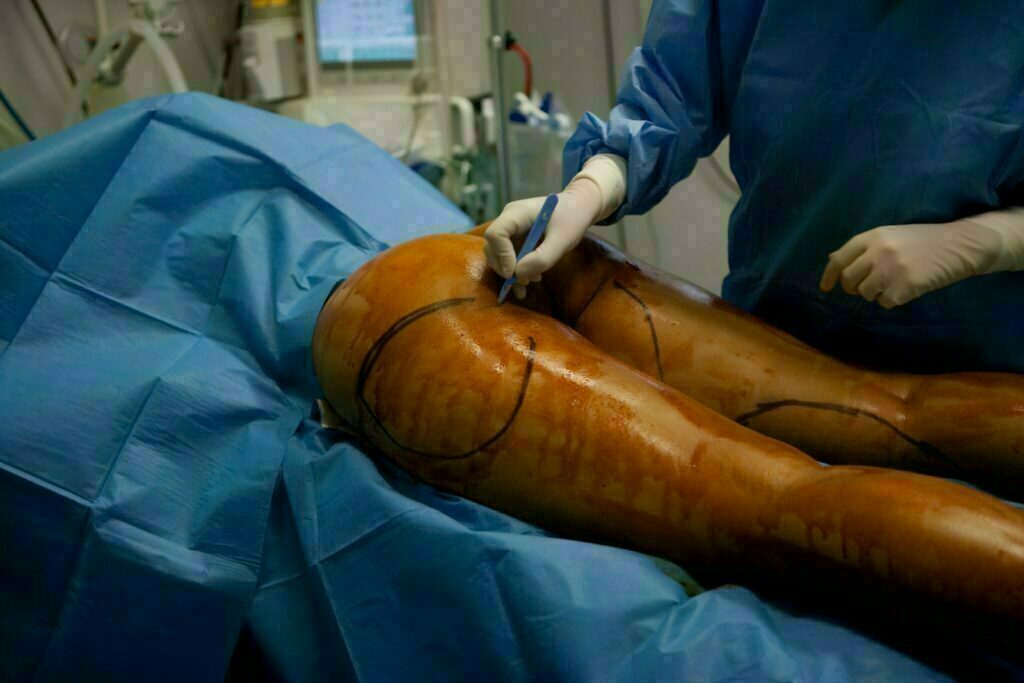Are you fed up with the loose, sagging skin that you want to tighten up efficiently? What if there’s a way of eliminating excess skin on your thigh following losing weight? In this article, we’ll discuss thigh lift surgery and thigh lift scars, as well as things to expect on Thigh Lift Scars After 1 Year.
The accumulation of fat in the thigh area could result from an absence of exercise and consequent overweight. The skin can also loosen because of sudden and excessive weight loss. The aging process can result in sagging as well as loose skin in this region. A sagging thigh shape can create a body that is imbalanced overall. If you’re experiencing lines on your thighs that you’re looking to get removed or are looking to get your skin tightened to get an energized and youthful appearance, then you’re in the right article.
A thigh lift, also known as thighplasty is a surgical procedure that involves the elimination of skin and fat, either from the outer or the inner thighs. It is typically recommended after weight loss through bariatrics or for people whose diet and exercise have not been able to eliminate excess tissue from their thighs. Liposuction can be utilized as an addition to the recontouring process of the thigh.
Candidates For a Thigh Lift Surgery

A lot of people looking to enhance the look and appearance of their lower thighs can be candidates for a thigh lift. However, you’ll have to meet certain criteria to be eligible for the procedure. These requirements help to keep you secure during the procedure and improve the chance of achieving your desired look.
You are qualified for a thigh lift in the event that you have a lot of skin or soft tissues on your thighs. It is also possible when you have achieved the weight-loss goals you have set and are able to maintain a healthy weight. In addition, losing weight following the thigh lift procedure could cause the thigh muscle to lose its shape. Additionally, the addition of gaining significant weight following the procedure could also affect the results.
Thigh lift surgery is also possible to apply if you are psychologically healthy. Our doctors will assess the possibility of your surgery by examining your body and medical history and discussing your goals during your initial appointment. Be aware that prior to undergoing the procedure, it is essential to be realistic about your expectations.
You’re also a good candidate for this thigh lift surgery if you are committed to a healthy lifestyle and exercise regularly to maintain the results. It is essential to be completely committed so that you will not waste your time or money. Don’t consume alcohol or smoke cigarettes during the prescribed time prior to and following the procedure as this could affect your recovery as well as increase the chances of suffering from complications.
Who Are Not Eligible For A Thigh Lift Surgery?

Patients suffering from a chronic illness such as diabetes are not eligible because it may hinder healing or cause harm under anesthesia or sedation. Alcoholics or smokers are not recommended to go through the process since they run a greater chance of complications and a failed recovery because of excessive bleeding from internal and external.
Women who are pregnant or suffering from cardiovascular conditions should not undergo this procedure since the anesthesia could cause harm to the fetus. Potential patients should also be mentally healthy. Not just with the body, but also with the mind. This kind of surgery can be difficult for people who have psychological disorders.
Thigh Lift Scars After 1 Year: Forms of Thigh Lift Scars

The extent and location of the scarring that results from your thigh lift will depend on the type of procedure you have undergone and also the type of skin you have and the speed at which your healing takes place. The scars are usually visible during the first six months. They could appear dark, pink, red, or hyperpigmented in some instances. In the coming twelve months, they will appear to be smoothing out slightly and get slightly lighter and more supple to the feel.
The most commonly seen leg lift scars can be easily concealed within the crease between the pubic region and the upper part of the thigh. Although they are quite large, you are able to conceal them with bathing suits or undergarments.
Spiral Thigh Lift Scars
An incline thigh lift is usually used by a person that has shed a substantial amount of weight, such as by bariatric surgery. They lift not only targets the thigh’s inner part but also the outer thigh as well, frequently the knees. It can be used to tighten loose skin close to the calves. It is the largest of all thigh lift techniques.
The scar from the thigh lift spiral can extend from the groin area to the knee, on the side of the thigh, and it can also extend from the groin up to the “under crease of the buttocks, and back towards the hips.
Lateral Thigh Lift Scars
A thigh lift that is also called the lateral thigh lift is typically performed in conjunction with other procedures, such as butt lifts or a tummy tuck. The incisions required to carry out the lateral lift may extend to allow for a lift or tummy tuck. Incisions are typically located near the upper edge of the buttock. It then extends into the hip region. The thigh lift scar on the lateral side is most noticeable within the first 6 months following surgery, and will gradually turn pink.
Lateral thigh lifts require the skills of a highly skilled surgeon due to the fact that the skin and fat within the outer part of the thighs are very heavy and require a special anchoring technique to stop the incisions from becoming open in the process of healing.
Crescent Thigh Lift Scars
An incision is cut at the junction between the pubic and thigh region. The surgeon then removes an oval-shaped piece of skin and fat from the area, then pulls the rest of the skin tightly, and secures it using stitches.
A crescent thigh lift scar is usually concealed in the crease of the thigh where it is joined to the groin. This thigh lift is one of the least noticeable marks of thigh lifts.
Inner (Medial) Thigh Lift Scars
In a medial thigh lift (inner thigh lift), the surgeon will take off loose skin and fat from the thighs’ inner areas (the area that connects) as well as around the knee region. The surgeon usually makes an incision through the groin region and then along the side of the leg up to the knee (in the shape of a T) or a straight vertical cut can be utilized. Extra loose skin and fat are removed from the inside of the thighs as well as around the knee area if required.
The scar on the inner thigh will appear like a straight vertical line that extends through the lower leg straight from the groin. Or, it appears to be the form of a T, with the top of the T concealed within the crease in which the thigh and groin meet and the rest flowing horizontally along the interior of your thigh. The scars on the inner thigh tend to be a little more challenging to cover, but they will fade as time passes.
How Long Does a Thigh Lift Last?
The results of a thigh lift typically last between five and ten years. However, the choices you make following surgery can determine how long the results last. Skin sagging is a typical result of the aging process. As you age, the more collagen and elastin, hyaluronic acid, and collagen the skin produces. This means that your skin’s appearance begins to change considerably. The more attentive you are to the condition of your skin and collagen, the longer your outcomes will be lasting.
Furthermore, the outcomes will last longer if you are successful in keeping your weight in check after the procedure. In many instances, this procedure is done to get rid of the excess skin caused by substantial weight loss. If you gain weight and then shed a significant amount of weight after surgery, there’s the possibility that you’ll end up with excess again. So, make sure to exercise and have a balanced diet to preserve the outcome.
Thigh Lift Scars After 1 Year – 2 Years
Many patients ask what time it will take to allow their scars to fade following a thigh lift surgery. They would like to know what they can expect from the thigh lift scars following one year or if they still notice the scars on their thighs after two years.
The way scarring appears is different for every patient, and several factors determine the extent to which the thigh lift scarring occurs and the length of time it will take for the scars to disappear. Scars caused by a thigh lift surgery are said to be more enduring than others and require some time to fade.
Typically, within one year, the thigh lift scars have faded to become much less prominent and flattened. If you have evident thigh lift marks after two years, you may want to think about an aesthetic procedure like light, laser, and microneedling treatment to reduce the appearance of their scars.
Thigh Lift Surgery Before and After

Care for your body’s health and planning your recovery time prior to the procedure will increase the chances of achieving outstanding results and decrease the chance of complications.
Before a Thigh Lift Procedure
After a set amount of time, you must cut down on drinking and smoking. Additionally, you should avoid certain supplements and drugs that can interfere with your healing and surgical process. Cleansing your thighs thoroughly to ensure your skin is clean and healthy prior to your procedure is also beneficial. The procedure will not be approved when your skin is infected.
Drinking plenty of water and taking supplements like iron and vitamin C to assist your body in undergoing and recovering after a thigh lift. The body can recover quicker in the various stages of healing if you have sufficient rest, so make sure you sleep well. Maintaining your exercise routine and eating nutritious meals is essential. Your weight needs to be stable for the thigh lift procedure. It is also necessary to keep this healthy lifestyle after the procedure in order to ensure your results are maintained.
If your eligibility for the surgery is in question, we may require an additional evaluation prior to performing your thigh lift. Make sure you also have someone on hand to help you with moving around your house or giving you medication following the surgery.
Finally, make arrangements to have a break from work. It is not possible to do any activity during the first few weeks following the thighplasty. Additionally, avoid having a meal for at least 12 hours prior to the time of your surgery. The stomach contents could make the process of undergoing anesthesia more difficult or even dangerous.
After a Thigh Lift Procedure
After surgery, incisions are bandaged, drains may be installed to stop the accumulation of fluids and blood, and a compression garment will be put on to keep the incisions. The nurses will keep an eye on and give you instructions for taking medications and repositioning your body not to cause disruption to your incisions and also to detect indications of complications so that they can be dealt with efficiently.
Prescribed aftercare painkillers should help you manage any pain/soreness/discomfort. It is recommended not to take aspirin or Ibuprofen for at least two days in order not to increase the risk of bleeding. Before leaving the surgical clinic, you must be able to move around comfortably and be able to carry all the medications you require and other supplies.
Due to the disorienting effect associated with anesthesia sedation and painkillers, a family member will be required to take you home after surgery. On top of that, for the 24 hours after surgery, for the subsequent care, you’ll require help with routine tasks such as cooking food or getting into the restroom. It is also necessary to take a break and align your body to ensure that you don’t stretch the thigh muscle. Utilize a cushion to relieve the strain off the legs as you heal.
Be sure to take small walks around your house to maintain blood flow. Additionally, avoid doing squats, climbing stairs, lifting objects that weigh a lot, or doing any strenuous exercise to speed up your recovery process following the thigh lift surgery.
Two days after the thigh lift procedure, you can shower, take care to remove your compression garment and bandages, and gently clean your legs. One week following the procedure, you’ll attend a follow-up visit where our doctors will inspect your thighs and answer any questions you might have. He will take out your drains and sutures if your incisions have healed.
After 2 or 3 weeks, the scars could appear more prominent or appear red at this time, but they’ll gradually fade over the coming several weeks or months. It is also possible to resume light exercises and drive.
After a month, Dr. Salameh or Dr. Saba will determine whether or not you should wear a compression garment. Additionally, bruising and swelling should decrease. If you experience discomfort or inflammation, consult our doctors, as this could be an indication of a complication.
After 6-8 weeks of your thigh lift surgery, it is possible to resume your usual routine of exercise, as long as Dr. Salameh or Dr. Saba has given you a go signal. In 6-12 months’ time, the recuperation process will be completed.
Realistic Expectations From A Thigh Lift Surgery
It’s not just about removing unwanted tissues. However, the procedure will give you a smoother and more youthful appearance. The thigh lift procedure is an option for those looking to shed weight quickly. It’s also a permanent method to rid yourself of the excess fat that accumulates on your thighs with a result that will last at least ten years.
The effects should be evident immediately following the procedure or, at the very least, a few weeks after surgery. The procedure can also result in mild scarring that is permanent. But, you can minimize the visible appearance of the marks if you live an active and healthy lifestyle or undergo laser, light, or micro-needling treatments. Also, remember that the firmness of your thighs will diminish over the course of time because of an inevitable process called aging.
Choosing The Right Surgeon

Choose someone who is accredited and has graduated from a recognized medical school. Not only will you rest assured that you’ll be safe, but you can also save time and money and, of course, the quality. Ask questions! The right surgeon will be happy to share their experiences about the procedure and brag about the testaments of their happy customers.
Dr. Bernard Salameh is one the top plastic surgeons in Kentucky, a double-board accredited by the American Board of Plastic Surgery (ABPS), trained at Yale University and went to the prestigious Vanderbilt University to specialize in Plastic Surgery is committed to you during the consultation up to the day of surgery.
The existence of two centers within Kentucky and Indiana permits it to be more accessible to those looking to undergo procedures such as Lipedema, Liposuction, and different body, breast, and facial surgeries.
Takeaway
As with all surgeries, the appearance of scars following thigh lift is expected, but our surgeons do this procedure in a manner that usually lets patients cover the scar. The size of the scar will differ depending on whether you’re undergoing surgery for an inner thigh lift that is restricted to the groin area or an entire medial thigh lift that could extend beyond the knee.
It is also crucial to adhere to the instructions of the surgeons. This will help heal and accelerate your progress towards a new appearance. It is also essential to keep all appointments for follow-up so that your surgeon is able to assess your long-term outcomes and address any concerns or questions.
Dr. Bernard Salameh at Salameh Plastic Surgery Center assesses patients through consultation and discusses their goals. By doing that, it will be easier to decide which approach is the best for you.
If you’re concerned about the procedure, you can visit us at Salameh Plastic Surgery Center – Bowling Green, KY, and Salameh Plastic Surgery Center- Evansville, Indiana.
Schedule a consultation with the top plastic surgeon in Indiana & Kentucky by clicking this link at Salameh Plastic Surgery Center or call us at (270) 904–7791.

